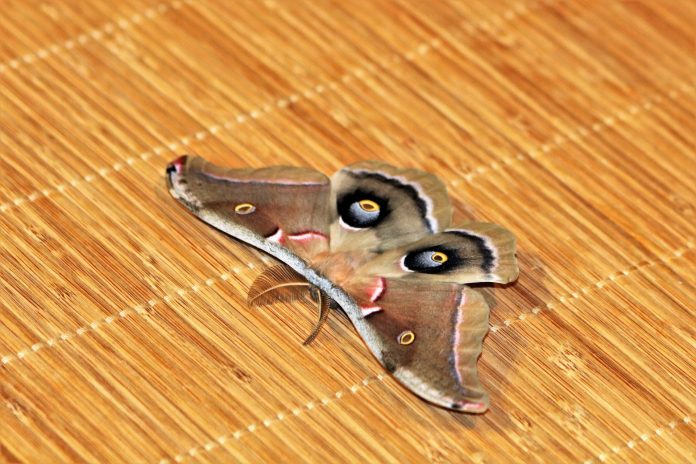It’s the season to enjoy large, winged creatures on the back porch. And I’m not referring to birds. I’m describing some of the more conspicuous giant silk moths.
Members of the family Saturniidae, silk moths are large, beautiful, and relatively uncommon. They are probably nontarget victims of annual campaigns to control gypsy moths with toxic insecticides.
To assemble a record of nocturnal visitors, collect images of them with a camera. Large moths mesmerized by porch lights are easy to capture on film.
Luna
One of the largest and easiest silk moths to recognize is the luna moth. Each spring I usually see several lunas. Often they are attracted to porch lights and cling to the screen on the storm door in the morning.
The long tails on the luna’s hind wings are as distinctive as its lime-green color.
Such visits begin in mid-May and may continue until midsummer. Luna wings can span up to 4.5 inches.
Several other large silk moths that visit the porch are equally impressive. Polyphemus and cecropia moths are even larger than lunas.
Polyphemus
Polyphemus moths are named after the one-eyed giant of Greek mythology. Polyphemus was a huge half-human Cyclops, the son of Poisidon and Thoosa. He is best known for capturing Odysseus in Homer’s Odyssey.
Odysseus and his men escaped when they drove a large sharpened stick into the monster’s hideous single eye. The name Polyphemus refers to the eyespots and honors the mythological character.
By suddenly revealing their eyespots when predators threaten, silk moths can startle hungry attackers and perhaps even escape to visit backyards another day.
Cecropia moths are grayish-brown with large white spots and red bands on the wings.
Lo and rosy maple moths are a bit smaller than the larger members of this group, but what they lack in size, they make up for in color. Lo moths are yellow with huge eyespots and red stripes on the rear wings.
Rosy maple moths have pink wings crossed by a broad yellow stripe.
Calls
Female silk moths attract mates by “calling” at certain times during the night. The “call” is a pheromone that is species specific in both its chemistry and timing.
Lunas, for example, call during the first two hours after midnight. Polyphemus moths call an hour before and after midnight, and if a female remains unmated, she will call again just before dawn.
Using their large feathery antenna, male silk moths can detect pheromones a mile away.
Capture a female silk moth, and you may be able to lure in some amorous males.
Place the female in a paper bag with some holes punched into it. Then clip the bag to a clothesline on the porch. The idea is that males within a mile can be attracted by the female’s pheromones when she calls.
Collect a few eggs you might find inside the bag and place them in a terrarium with an assortment of fresh oak, cherry, maple and hickory leaves. Now you have a chance to raise a brood of silk moth caterpillars.
Before transforming into a large silky cocoon, the fleshy green caterpillars of larger species can approach 4 inches in length.
After mating, females lay their eggs and most adult moths are probably eaten by bats, whip-poor-wills, screech-owls, or even flying squirrels. But that’s OK.
The sole purpose of adult moths is to reproduce. They lack functional mouthparts and survive on body fat for just a week or two.
Females are simply egg-laying machines, and males produce sperm. After mating, their job is done.
Silk moths live as caterpillars during the warmer months and overwinter in their papery cocoons.
Reference
For help identifying moths, I recommend A Golden Guide: Butterflies and Moths by Robert Mitchell and Herbert Zim ($6.95 on amazom.com).
First published in 1962, this classic little guide remains my favorite for identifying the common moths and butterflies I find in the backyard.














I have a bunch of eggs from the giant silk moth I found her on my porch it was raining and windy so I brought her in this is how I ended up with lots of eggs I bought the butterfly net cage for them but I’m not sure what to give them to eat out of all the food they eat lialac is the only one in yard on the list of food? It’s almost 2 weeks now been watching for the hatching to start…I’m in reno never northern part border to California should I just give them lialac?